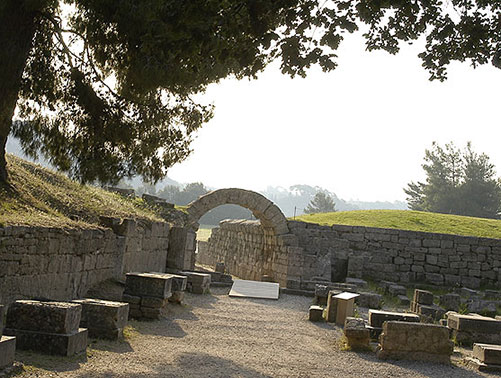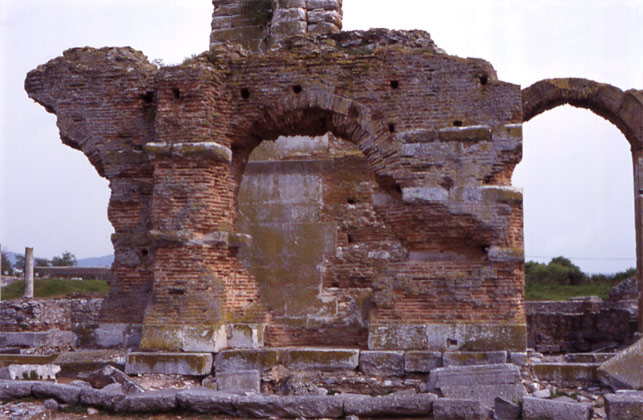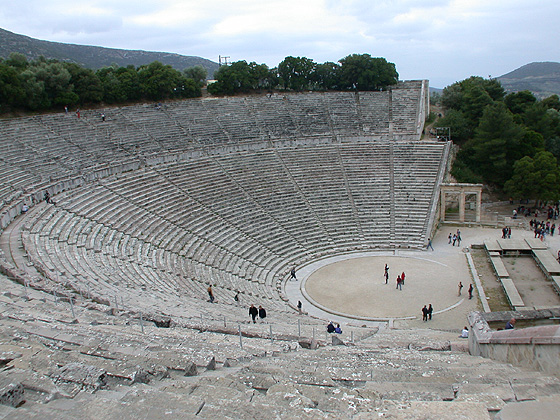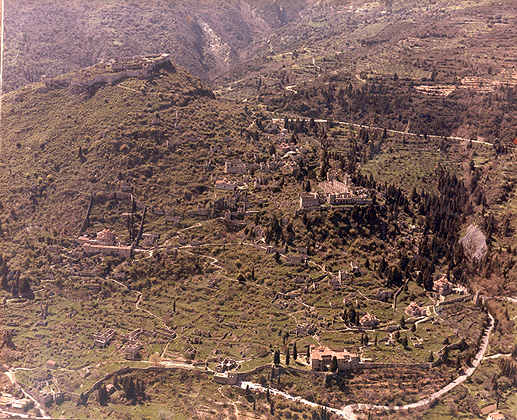The archeological site of Mystras is located about five kilometers west of Sparta, at the foot of Mt. Taygetos. The history of the site begins after the overthrow of the Byzantine Empire by the Latins in 1204 and the fragmentation of its territories. The Franks founded the so-called principality of Achaia (or Principality of Morea) under the leadership of William II of Villehardouin, who after his final supremacy throughout the Peloponnese, in 1249 built on the hill of Μυτζιθρά (as was the territory known at that time) a castle-seat of its territory. The choice of site was very successful, as the hill was located in a key point of the Peloponnese and was extremely fortified.
Historical circumstances of the next decade contributed decisively to the role that Mystras acquired as one of the most important urban centers of the late Byzantine Empire. Specifically, in 1259, in the battle of Pelagonia (today North Macedonia) between the principality of Achaia and the Byzantine Empire of Nicaea, the Franks were defeated and William himself was taken prisoner. In order to be liberated, the Frankish ruler granted the Byzantines important castles of the Peloponnese, including Mystras, which from 1262 became the seat of a Byzantine general. Using the castles granted to them as a base, the Byzantines tried to re-establish themselves in the Peloponnese, while at the same time the orthodox population of the valley of Evrotas settled on the hill quickly. The culmination of the foundation of the state was the re-establishment of the Diocese of Lacedaemon based in Mystras.
The city developed over the entire surface of the hill covering an area of about 20 hectares and in its heyday (14th-15th century) the population did not exceed the 5-6,000 inhabitants. On the top of the hill was the fortress and on its slopes a fortified settlement developed, divided by an inner line of walls into two zones: the Upper and the Lower Town. The Upper Town hosted the residence of the commander (the later palace of the “despot” of Mystras), and the Lower Town the Metropolis. Houses were located in both zones, and after the middle of the 14th century mansions of renowned families were built not only on the higher parts of the hill, but also in the Lower Town. The lower part of the settlement, however, was characterized by denser habitation and hosted shops and markets.
Within the city there were four monasteries (Vrontochiou, Christos Zoodotis, Pantanassa, Perivleptos), the metropolitan church, the cemetery church of Evangelistria, as well as numerous chapels. Most of these survive to this day, which together with the fortifications, the palace and the mansions, the simplest houses, the shops and craft installations, make Mystras one of the few preserved examples of a Byzantine city and a valuable ensemble for the study of its fortification, secular and ecclesiastical architecture, and monumental art of the last centuries of the Byzantine Empire. In the churches in particular, Greek, Constantinopolitan, but also western elements are present, a phenomenon that represents well the cultural hybridity that took place in the area at that time.
Mystras’ relationship with Constantinople was particularly strong. The most important families of the last two centuries of the empire, the Kantakouzenoi and the Palaiologoi, were inextricably linked to Mystras. The Despotate of Morea was the most important area of the Byzantine state beyond the outskirts of the capital at that time, and many later emperors (or their sons) were its despots. This connection is also reflected in the intellectual life of the place. The city was an important center for copying manuscripts, while in the 15th century the Neoplatonic philosopher George Plethon Gemistos settled (and died) on the site. His disciple was the Cardinal Bessarion, who had accompanied the Byzantine emperor John Palaiologos to the Ferrara / Florence Synod (1438/9) on the subject of the negotiation of the union of the churches, while later (1468) he donated to Venice (1468) around 1000 volumes which formed the core of the famous Marciana Library.
Mystras, apart from being an intellectual was also a financial center. The four urban monasteries, which owned a large amount of land in the area, played a key role in this. The main production of the place was wool and silk. An important factor in economic and commercial activity (especially after the occupation of Mystras by the Ottomans in 1460) was also the Jewish community that had existed since the 14th century in the region, and which gradually gained control of trade in the area.
During the Ottoman period, Mystras continued to prosper. The palace of the Upper City was transformed into the seat of the Ottoman commander and the temples of Hagia Sophia and Ηοdegetria became mosques. The Jewish community grew and the population then lived outside the city walls. In the 17th century Mystras still had more than 1,000 inhabitants.
The prosperity of the place lasted until the end of the 18th century. Due to the riots that arose during the Orlov Revolt and the Greek revolution in the late 18th and early 19th centuries, Mystras was attacked by the Turks, from which it practically never recovered. Gradually the settlement withered and became deserted as a result of the movement of the population to the city of Sparta, founded by Otto in 1834. The last few inhabitants who remained on the site left in 1955, when Mystras began to function as an archaeological site.
The first archaeological studies and restoration works had already started in the early 20th century. Many monuments were in ruins from the catastrophes of the 18th and 19th centuries, but also due to natural erosion. The heavy rains, the wild vegetation and the intense fluctuations in temperature and humidity had a particularly negative effect on the sensitive mortars, coatings, and murals of the monuments of Mystras, while equally devastating for the buildings themselves were the earthquakes and the effects of landslides. Restoration work has intensified since 1984, when the Committee for the Restoration of Monuments of Mystras was established.
Sources
Runciman, Mistra. Byzantine capital of the Peloponnese, London 1980,
Μ. Hadzidakis, Μυστράς. Η μεσαιωνική πόλη και το κάστρο, Athens 1981,
“Mistra”, in The Oxford Dictionary of Byzantium, vol. II, Oxford 1991, 1382-1385,
S. Sinos (Ed.), Τα μνημεία του Μυστρά. Το έργο της Επιτροπής Αναστήλωσης Μνημείων του Μυστρά, Αθήνα 2009,
S. Kalopissi-Verti, Mistra: A fortified late byzantine settlement, in J. Albani and E. Chalkia (Eds,), Heaven and Earth: Cities and countryside in Byzantine Greece, Athens 2013, 224-239.









